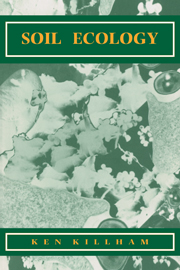Book contents
- Frontmatter
- Dedication
- Contents
- Foreword
- Introduction
- 1 The soil environment
- 2 The soil biota
- 3 Ecological interactions between the soil biota
- 4 The ecology of soil nutrient cycling
- 5 Ecology of extreme soil environments - soil water stress
- 6 Ecology of polluted soils
- 7 Manipulation of soil ecology - ‘soil biotechnology’
- References
- Further reading
- Index
- Frontmatter
- Dedication
- Contents
- Foreword
- Introduction
- 1 The soil environment
- 2 The soil biota
- 3 Ecological interactions between the soil biota
- 4 The ecology of soil nutrient cycling
- 5 Ecology of extreme soil environments - soil water stress
- 6 Ecology of polluted soils
- 7 Manipulation of soil ecology - ‘soil biotechnology’
- References
- Further reading
- Index
Summary
INTRODUCTION
The previous chapter considered the more important of the physical and chemical factors that contribute to make the soil a varied habitat (or range of microhabitats) and explained much of this heterogeneity in terms of distribution and function of the soil biota. This chapter briefly describes the chief components of the soil biota and demonstrates the incredible biodiversity of the soil community. Figure 6 illustrates some representatives of the main components of this community. The viruses, which are generally about 0.1 jam in length, are too small for realistic inclusion. Also for obvious reasons, the larger soil animals, such as moles and rabbits, cannot be considered.
The plant roots, microbes and animals that make up the soil biological community produce intracellular and extracellular enzymes that are responsible for much of the biogeochemical cycling in the soil. The ecological significance of soil enzymes is discussed in Chapter 4.
PLANT ROOTS
Since the classic work on plant root systems by Weaver (1926), a picture has gradually been emerging of plant root systems as an incredibly labile and varied component of the soil biomass. The volume of surface soil occupied by plant root systems obviously varies with the vegetation present and the soil environment for root exploitation but can be as much as 5% or more, although values of about 1% are probably more typical.
Root systems extend through the soil by division and elongation of cells at or near to the root tip. The root tip consists of a protective cap, which controls the geotrophic curvature of the root, surrounded by a film of mucilage, which is a largely polysaccharidic slime secreted by the outer cells of the root cap. Behind the cap is the zone of the root (the meristematic zone) in which cell division occurs. Behind the meristematic zone, the new cells elongate and differentiate prior to maturation and the development of root hairs. The extension of main root axes and of laterals through the soil follows a similar story.
With very few exceptions, laterals are produced from main root axes to enable a branched root system to develop in the soil.
- Type
- Chapter
- Information
- Soil Ecology , pp. 34 - 61Publisher: Cambridge University PressPrint publication year: 1994
- 1
- Cited by



